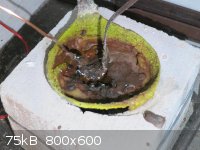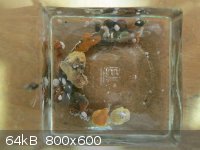metalresearcher
National Hazard
   
Posts: 732
Registered: 7-9-2010
Member Is Offline
Mood: Reactive
|
|
Electrolyzing NaOH: finally succeeded !
Finally I electrolyzed NaOH. The first time with success. In a large stainless steel soup dipper I melted NaOH prills (which got brown due to
dissolved metal oxides from the stainless steel and the copper cathode).
I used a copper strip as cathode and the dipper itself as anode. I used an 8 Amp battery charger and a halogen bulb in series to prevent short
circuiting. There were some small explosions due to water vapor from the anode reacting with the Na metal. I had to keep the temperature near
freezing, i.e. between 320 and 330 C to prevent dissolving of the Na metal in the lye. It was not easy to pick the small (liquid) Na balls (3-5mm)
from the bath, they slipped easily back into the bath, but I got some in the lamp oil.
<iframe sandbox width="640" height="360" src="//www.youtube.com/embed/Lp1SC9UWyRo" frameborder="0" allowfullscreen></iframe>
[Edited on 2013-11-9 by metalresearcher]
|
|
|
Random
International Hazard
    
Posts: 1018
Registered: 7-5-2010
Location: In ur closet
Member Is Offline
Mood: Energetic
|
|
Good work, I hope you can improve the procedure with a bigger yield in the future. Molten NaOH looks scary though, I bet it would eat away all flesh
to the bone at that temp.
|
|
|
deltaH
Dangerous source of unreferenced speculation
    
Posts: 1663
Registered: 30-9-2013
Location: South Africa
Member Is Offline
Mood: Heavily protonated
|
|
A side question please, when sodium forms at the cathode, why does it not simply react with hydroxide to form sodium oxide and hydrogen gas by this
reaction:
2Na + 2NaOH => 2Na2O + H2
What I'm trying to get at is why use NaOH melt if it is still a protic 'solvent'/electrolyte of sorts no?
[Edited on 9-11-2013 by deltaH]
|
|
|
blogfast25
International Hazard
    
Posts: 10562
Registered: 3-2-2008
Location: Neverland
Member Is Offline
Mood: No Mood
|
|
Quote: Originally posted by deltaH  | A side question please, when sodium forms at the cathode, why does it not simply react with hydroxide to form sodium oxide and hydrogen gas by this
reaction:
2Na + 2NaOH => 2Na2O + H2
|
I think you'll find the answer to ALL your questions on NaOH(l) electrolysis here:
http://www.sciencemadness.org/talk/viewthread.php?tid=9797
In short, this is how it's done! len1 must be one of the very few in the entire world to have built a lab scale functioning Castner cell. Hats off,
once again.   
|
|
|
deltaH
Dangerous source of unreferenced speculation
    
Posts: 1663
Registered: 30-9-2013
Location: South Africa
Member Is Offline
Mood: Heavily protonated
|
|
Thanks for the link blogfast and hats off from me too... very brave experimentalist! I would have been petrified!
|
|
|
blogfast25
International Hazard
    
Posts: 10562
Registered: 3-2-2008
Location: Neverland
Member Is Offline
Mood: No Mood
|
|
Quote: Originally posted by deltaH  | | Thanks for the link blogfast and hats off from me too... very brave experimentalist! I would have been petrified!
|
He was probably the best experimentalist here on SM in recent years. Sadly he doesn't stop by too often anymore.
|
|
|
WGTR
National Hazard
   
Posts: 971
Registered: 29-9-2013
Location: Online
Member Is Offline
Mood: Outline
|
|
metalresearcher congratulations on joining the sodium club! We look forward to hearing more of your exploits in the future.
|
|
|
metalresearcher
National Hazard
   
Posts: 732
Registered: 7-9-2010
Member Is Offline
Mood: Reactive
|
|
Well, I have tried another run, I was able to collect sodium again but there are a few issues. It is a thick brown slurry which makes collection
difficult.
The reason is probably that I use the stainless steel container itself as an anode and the brown and yellow slurry is dissolving Cr2O3 and Fe2O3 from
the attacked stainless steel.
And I don't want to heat it too much otherwise the Na metal dissolves into the lye.
So my next setup will be a separate anode (nickel).
In the collected items (second photo) there is a lot of frozen NaOH + metal oxide crud.
 
|
|
|
blogfast25
International Hazard
    
Posts: 10562
Registered: 3-2-2008
Location: Neverland
Member Is Offline
Mood: No Mood
|
|
Metalresearcher: this kind of set up is definitely a valid way of preparing small amounts of sodium metal in the lab. A.F. Holleman describes it in
'Inorganic Chemistry'. But you need nickel to take this any further. The sodium metal is usually collected using a metal gauze spoon.
|
|
|
Fantasma4500
International Hazard
    
Posts: 1681
Registered: 12-12-2012
Location: Dysrope (aka europe)
Member Is Offline
Mood: dangerously practical
|
|
i think the metal alloy might be problematic for this.. 316 works decently for handling NaOH, although food grade steel is not always that good for
electrolysis for some reason
there is another alloy thats relatively common thats better for caustic enviroments however.. i suppose this would be better for molten NaOH
not sure if the more resistant steel was 308L?
|
|
|
metalresearcher
National Hazard
   
Posts: 732
Registered: 7-9-2010
Member Is Offline
Mood: Reactive
|
|
What about using candle wax (paraffin) on top of the lye ?
The paraffin boils @ 370C (according to the largest online chemistry textbook) so above the electrolysis temperature (320-330 C) and protects the Na metal against air ?
Or is this a very bad / unsafe idea as the candle wax ignites easily @ 330 C ?
|
|
|
bbartlog
International Hazard
    
Posts: 1139
Registered: 27-8-2009
Location: Unmoored in time
Member Is Offline
Mood: No Mood
|
|
Cast iron is a better choice than most regular steel alloys. A nickel plated vessel would be even better, though. As for trying to cover the lye with
some nonreactive fluid, I can't think of anything that would work. Easier to just have a lid once you get to the point where you don't need to observe
the reaction the entire time.
The less you bet, the more you lose when you win.
|
|
|
deltaH
Dangerous source of unreferenced speculation
    
Posts: 1663
Registered: 30-9-2013
Location: South Africa
Member Is Offline
Mood: Heavily protonated
|
|
metalresearcher, a silver plated spoon or one marked EPNS might make a good anode. Silver oxide decomposes at 280C, so in molten
sodium hydroxide temperature, it shouldn't even form, plus EPNS stands for electroplated nickel silver, so the nickel is there as well! Just make
sure there's a decent layer of the plating left on your spoon, if there are deep scratches or worn off patches, it will probably corrode from there
quickly! However, I wouldn't use one that has any value!
Using wax for your system is not a good idea. This is because long aliphatic hydrocarbons have very low autoignition temperatures, for
example why diesel is used in diesel engines. Polyaromatic hydrocarbons (PAHs) have much higher autoignition temperatures (usually much higher than
their bp), but their flash points are still roughly half of their boiling points! So one sparc and it WILL ignite  NOT safe either, plus they are carcinogenic!!! NOT safe either, plus they are carcinogenic!!!
Polyethylene might work as a shielding melt, but you would need to research the safety of this FIRST!
[Edited on 16-11-2013 by deltaH]
|
|
|
blogfast25
International Hazard
    
Posts: 10562
Registered: 3-2-2008
Location: Neverland
Member Is Offline
Mood: No Mood
|
|
Greatly increasing the chances of a fire involving molten lye isn't clever, IMO.
How about trying an imperfect Ar blanket by gently blowing welding argon over the melt's surface?
|
|
|
m1tanker78
National Hazard
   
Posts: 685
Registered: 5-1-2011
Member Is Offline
Mood: No Mood
|
|
Keep this cruddy sodium. A while back I posted a set of procedures to recover pure sodium from NaCl-sodium crud. Should work for NaOH-sodium crud too.
It helps to smash the bits first.
As for the melt, remember that oxides and carbonates (to name a couple) poison your NaOH melt by raising the temperature needed to keep it molten.
You'll instinctively raise the heat and/or current and wonder why much of the sodium is diffusing back into the melt.
If you have argon available (as blogfast suggested), try building a hedge around your crucible and gently blow in some Ar. This should extend the
useful life of your electrolyte some.
Tank
Chemical CURIOSITY KILLED THE CATalyst.
|
|
|